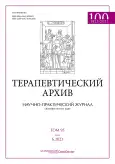Clinical significance of uremic toxin indoxyl sulfate and inflammation in the development of vascular calcification and cardiovascular complications in stage C3–C5D chronic kidney disease
- Authors: Dzgoeva F.U.1, Remizov O.V.1, Goloeva V.G.1, Ikoeva Z.R.1
-
Affiliations:
- North Ossetian State Medical Academy
- Issue: Vol 95, No 6 (2023)
- Pages: 468-474
- Section: Original articles
- URL: https://journals.rcsi.science/0040-3660/article/view/133106
- DOI: https://doi.org/10.26442/00403660.2023.06.202267
- ID: 133106
Cite item
Full Text
Abstract
Aim. To clarify the role of the uremic toxin indoxyl sulfate (IS) and inflammation in the development of vascular calcification and cardiovascular complications in chronic kidney disease (CKD).
Materials and methods. One hundred fifteen patients aged 25 to 68 years with CKD stage C3–C5D were examined. Serum concentrations of IS, interleukin 6 (IL-6), tumor necrosis factor (TNF-α), troponin I, parathyroid hormone were determined by enzyme immunoassay using kits from BluGene biotech (Shanghai, China), Cloud-Clone Corp. (USA), ELISA Kit (Biomedica, Austria).
Results. An increase in the serum concentration of IS, IL-6, TNF-α was revealed, which was significantly associated with a deterioration in renal function and changes in the morphological and functional parameters of the heart and aorta.
Conclusion. High concentrations of IS, IL-6, TNF-α, which are closely associated with an increase in renal failure and cardiovascular complications, indicate their significant role in vascular calcification, which underlies the damage to the cardiovascular system in CKD.
Full Text
##article.viewOnOriginalSite##About the authors
Fatima U. Dzgoeva
North Ossetian State Medical Academy
Author for correspondence.
Email: fdzgoeva@mail.ru
ORCID iD: 0000-0002-7314-9063
д-р мед. наук, проф. каф. внутренних болезней №5
Russian Federation, VladikavkazOleg V. Remizov
North Ossetian State Medical Academy
Email: fdzgoeva@mail.ru
ORCID iD: 0000-0003-4175-5365
д-р мед. наук, проф. каф. лучевой диагностики с лучевой терапией и онкологией
Russian Federation, VladikavkazVictoria G. Goloeva
North Ossetian State Medical Academy
Email: fdzgoeva@mail.ru
ORCID iD: 0000-0001-5310-889X
аспирант каф. внутренних болезней №5
Russian Federation, VladikavkazZarina R. Ikoeva
North Ossetian State Medical Academy
Email: fdzgoeva@mail.ru
ORCID iD: 0000-0002-4183-2335
аспирант каф. внутренних болезней №5
Russian Federation, VladikavkazReferences
- Villain C, Metzger M, Combe C, et al. Prevalence of atheromatous and non-atheromatous cardiovascular disease by age in chronic kidney disease. Nephrol Dial Transplant. 2020;35(5):827-36. doi: 10.1093/ndt/gfy277
- Tian N, Yan Y, Chen N, et al. Relationship between gut microbiota and nutritional status in patients on peritoneal dialysis. Sci Rep. 2023;13(1):1572-83. doi: 10.1038/s41598-023-27919-3
- Wang H, Ainiwaer A, Song Y, et al. Perturbed gut microbiome and serum metabolomes are associated with chronic kidney disease severity. Microbiome. 2023;11(1):3-11. doi: 10.1186/s40168-022-01443-4
- Chao CT, Lin SH. Uremic Vascular Calcification: The Pathogenic Roles and Gastrointestinal Decontamination of Uremic Toxins. Toxins (Basel). 2020;12(12):812-8. doi: 10.3390/toxins12120812
- Fujii H, Goto S, Fukagawa M. Role of Uremic Toxins for Kidney, Cardiovascular, and Bone Dysfunction. Toxins (Basel). 2018;10(5):202. doi: 10.3390/toxins10050202
- Li F, Wang M, Wang J, et al. Alterations to the Gut Microbiota and Their Correlation With Inflammatory Factors in Chronic Kidney Disease. Front Cell Infect Microbiol. 2019;9:206. doi: 10.3389/fcimb.2019.00206
- Akchurin OM, Kaskel F. Update on inflammation in chronic kidney disease. Blood Purif. 2015;39(1-3):84-92. doi: 10.1159/000368940
- Filipska I, Winiarska A, Knysak M, Stompór T. Contribution of Gut Microbiota-Derived Uremic Toxins to the Cardiovascular System Mineralization. Toxins (Basel). 2021;13(4):274. doi: 10.3390/toxins13040274
- Gao Y, Li Y, Duan X, et al. Research progress on the relationship between IS and kidney disease and its complications. Int Urol Nephrol. 2022;54(11):2881-90. doi: 10.1007/s11255-022-03209-1
- Koppe L, Soulage CO. The impact of dietary nutrient intake on gut microbiota in the progression and complications of chronic kidney disease. Kidney Int. 2022;102(4):728-39. doi: 10.1016/j.kint.2022.06.025
- Das S, Gnanasambandan R. Intestinal microbiome diversity of diabetic and non-diabetic kidney disease: Current status and future perspective. Life Sci. 2023;316:121414. doi: 10.1016/j.lfs.2023.121414.
- Tourountzis T, Lioulios G, Fylaktou A, et al. Microbiome in Chronic Kidney Disease. Life (Basel). 2022;12(10):1513. doi: 10.3390/life12101513
- Wang H, Ainiwaer A, Song Y, et al. Perturbed gut microbiome and serum metabolomes are associated with chronic kidney disease severity. Microbiome. 2023;11(1):3. doi: 10.1186/s40168-022-01443-4
- Mao ZH, Gao ZX, Liu DW, et al. Gut microbiota and its metabolites – molecular mechanisms and management strategies in diabetic kidney disease. Front Immunol. 2023;14:1124704. doi: 10.3389/fimmu.2023.1124704
- Graboski AL, Redinbo MR. Gut-Derived Protein-Bound Uremic Toxins. Toxins (Basel). 2020;12(9):590. doi: 10.3390/toxins12090590
- Lun H, Yang W, Zhao S, et al. Altered gut microbiota and microbial biomarkers associated with chronic kidney disease. Microbiologyopen. 2019;8(4):e00678. doi: 10.1002/mbo3.678
- Hobby GP, Karaduta O, Dusio GF, et al. Chronic kidney disease and the gut microbiome. Am J Physiol Renal Physiol. 2019;316(6):F1211-7. doi: 10.1152/ajprenal.00298.2018
- Rysz J, Franczyk B, Ławiński J, et al. The Impact of CKD on Uremic Toxins and Gut Microbiota. Toxins (Basel). 2021;13(4):252. doi: 10.3390/toxins13040252
- Bhargava S, Merckelbach E, Noels H, et al. Homeostasis in the Gut Microbiota in Chronic Kidney Disease. Toxins (Basel). 2022;14(10):648. doi: 10.3390/toxins14100648
Supplementary files









